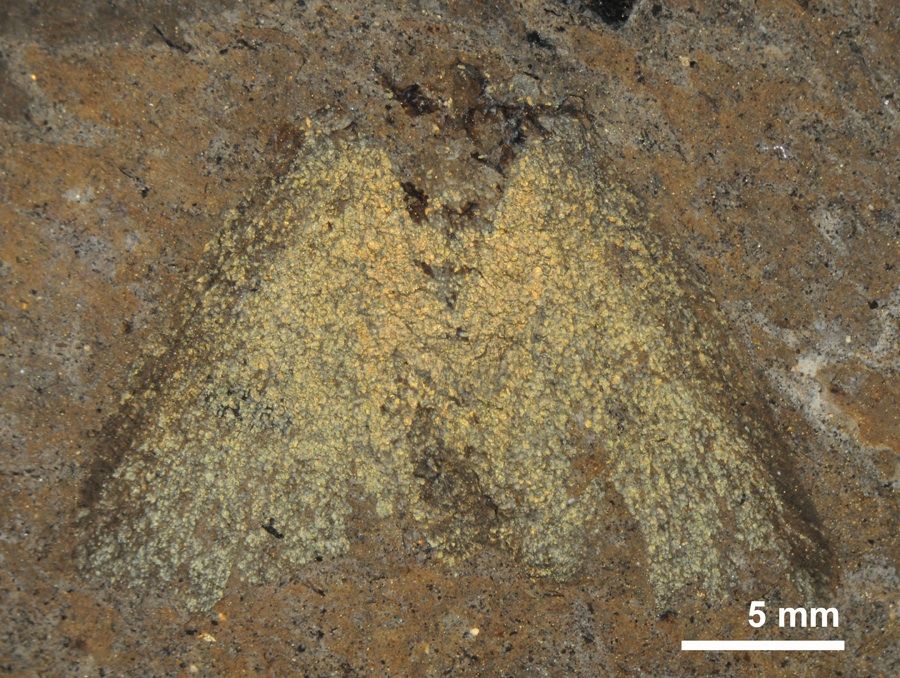Ancient Moths Reveal Their True Colors

Fossilized moth wings that look blue in death would have been yellow-green in life, a new study finds, suggesting a colorful method of camouflage and warning.
The moths probably used their colors some 47 million years ago to blend in with leaves and grass while nesting, according to study researcher Maria McNamara, a paleobiologist and postdoctoral researcher at Yale University. But modern butterflies with the same colors contain toxic cyanide in their tissues, so the yellow-green may also have been a warning to predators when the moths were out and about looking for nectar.
"They were probably using the color for the same kind of function," McNamara told LiveScience, "to hide themselves when they were resting, but as a warning signal when they were feeding." [Photos of the fossilized moths]
Structural colors
McNamara and her colleagues are interested in structural colors, the sort of color that is not created by pigment but by the organization of an organism's tissues. For example, the researchers have found that some ancient species of fossilized beetle got their metallic sheen from light scattering as it bounced off their exoskeletons. Fossilization tends to alter these colors slightly, McNamara found, but it's possible for researchers to reconstruct how the structures would have scattered light in life.
McNamara was poring over fossils from the famed Messel oil shale in Germany when she came across the remains of several moth species, all belonging to a group called lepidopterans, which also includes butterflies. The Messel site is famous for well-preserved, intricate fossils. This level of anatomical detail allows researchers to look at the tiny, featherlike scales on the ancient moths' wings that would have been responsible for structural color. Then, using mathematical analysis, they can reconstruct the colors as they would have looked pre-fossilization.
"When you look at these fossils today in air, their wings look a blue-green color," McNamara said. "But we were able to work out that originally, their wings were more of a yellow-green color."
Sign up for the Live Science daily newsletter now
Get the world’s most fascinating discoveries delivered straight to your inbox.
The distinction may seem modest, but it conveys a lot of information about the moths' lives, McNamara said. For one thing, the fact that the moths had color at all reveals that the various species were daytime creatures, not like the ghostly white moths of today that flutter around porch lights. The color wasn't iridescent, so it looked the same from any angle. That is a mark of camouflage, McNamara said.
And the color draws a potential link between today's lepidopterans and 47-million-year-old moths, given that this yellow-green hue is still seen today in cyanide-carrying butterflies, McNamara said.
Preliminary results from this study also suggest that moth fossils that look boring brown today may still preserve structures that would have created color in life, McNamara said.
"You might be able to reconstruct colors of other butterfly and fossil moths that just look brown today," she said. "It's part of the whole process of working out what animals have used colors for in the past."
McNamara and her colleagues report their work in today's (Nov.15) issue of the open-access journal PLoS Biology.
You can follow LiveScience senior writer Stephanie Pappas on Twitter @sipappas. Follow LiveScience for the latest in science news and discoveries on Twitter @livescience and on Facebook.

Stephanie Pappas is a contributing writer for Live Science, covering topics ranging from geoscience to archaeology to the human brain and behavior. She was previously a senior writer for Live Science but is now a freelancer based in Denver, Colorado, and regularly contributes to Scientific American and The Monitor, the monthly magazine of the American Psychological Association. Stephanie received a bachelor's degree in psychology from the University of South Carolina and a graduate certificate in science communication from the University of California, Santa Cruz.










